The Thief and the Cobbler
7.2 /10 1 Votes
Initial DVD release March 8, 2005 Duration Language English | 7.2/10 IMDb Genre Animation, Adventure, Comedy Country United KingdomUnited States | |||||||||||||||||||||||||||||||||
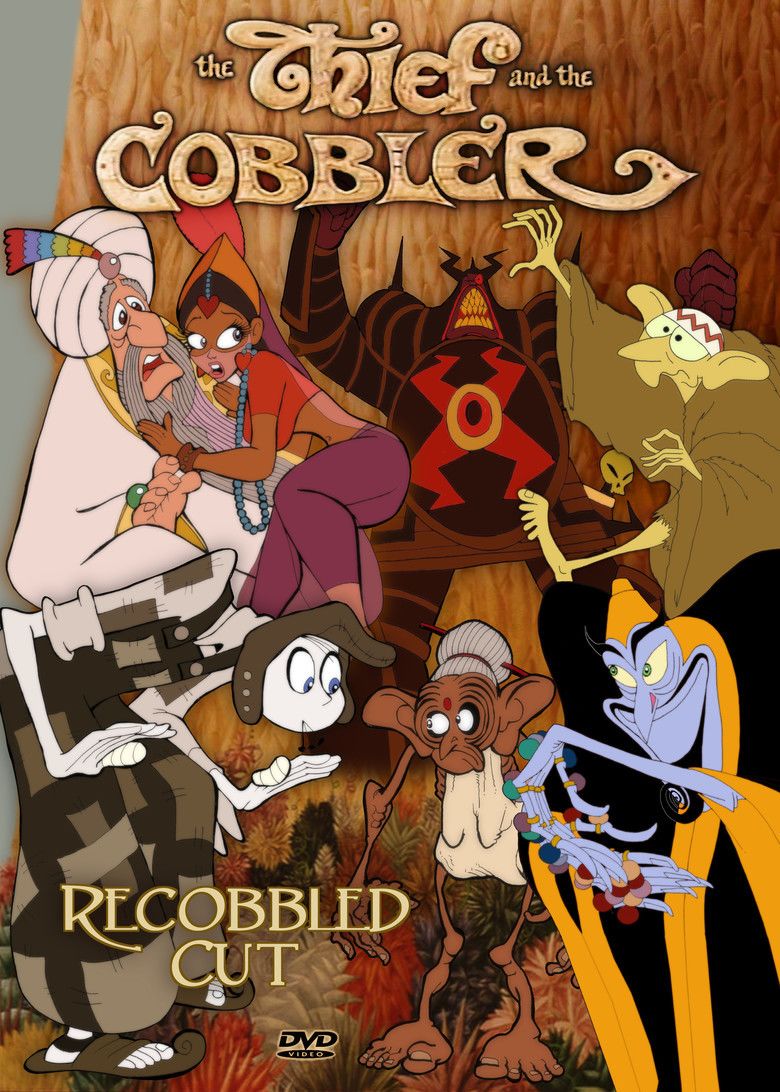 | ||||||||||||||||||||||||||||||||||
Release date September 23, 1993 (1993-09-23) (Princess (Australia))August 25, 1995 (1995-08-25) (Arabian (United States)) Writer Richard Williams (created by), Richard Williams (screenplay), Margaret French (screenplay), Parker Bennett (additional story and dialogue), Terry Runte (additional story and dialogue), Bette L. Smith (additional story and dialogue), Tom Towler (additional story and dialogue), Stephen Zito (additional story and dialogue), Eric Gilliland (additional dialogue), Michael Hitchcock (additional dialogue), Gary Glasberg (additional dialogue) Cast (Zigzag the Grand Vizier), (King Nod), (Tack the Cobbler), (Mad Old Holy Witch), Paul Matthews (Mighty One-Eye), (Phido the Vulture)Similar movies Aladdin (1992) | ||||||||||||||||||||||||||||||||||
The thief and the cobbler recobbled cut mark 4 pt 1
The Thief and the Cobbler is an animated fantasy film directed, co-written and co-produced by Canadian animator Richard Williams. The film is famous for its long, troubled history. Due to independent funding and complex animation, The Thief and the Cobbler was in and out of production for over three decades. It was finally placed into full production in 1988 when Warner Bros. agreed to finance and distribute the film. Negotiations broke down when production went over budget and behind schedule. Warner Bros. pulled out and a completion bond company assumed control of the film. The film was re-edited and re-structured by producer Fred Calvert without Williams' involvement, and released in Australia and South Africa as The Princess and the Cobbler in 1993; two years later, Miramax Films, at the time a subsidiary of Disney, released an even more heavily edited version of the film in North America under the title Arabian Knight.
Contents
- The thief and the cobbler recobbled cut mark 4 pt 1
- The thief and the cobbler miramax video trailer
- Plot
- Changes made in subsequent versions
- Notes
- Development and early production as Nasrudin 19641972
- Prolonged production 19721978
- Gaining financial backing 19781988
- Production under Warner Bros 19891992
- Production under Fred Calvert 19921993
- Releases
- Home media
- Reception
- Influence
- Restoration attempts
- Academy preservation
- Documentary
- The thief and the cobbler nostalgia critic
- References

With The Thief and the Cobbler being in and out of production from 1964 until 1995, a total of 31 years, it surpassed the 20-year Guinness record previously held by Tiefland (1954). This was, upon release, the last film of Kenneth Williams, who died in 1988, Sir Anthony Quayle, who died in 1989, and Vincent Price, who died in 1993, a month after the film's release. This is also, to date, the final film to feature Stanley Baxter.
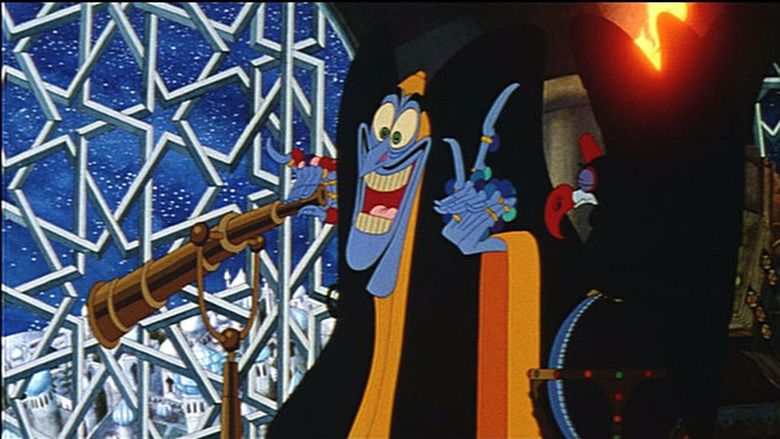
The thief and the cobbler miramax video trailer
Plot
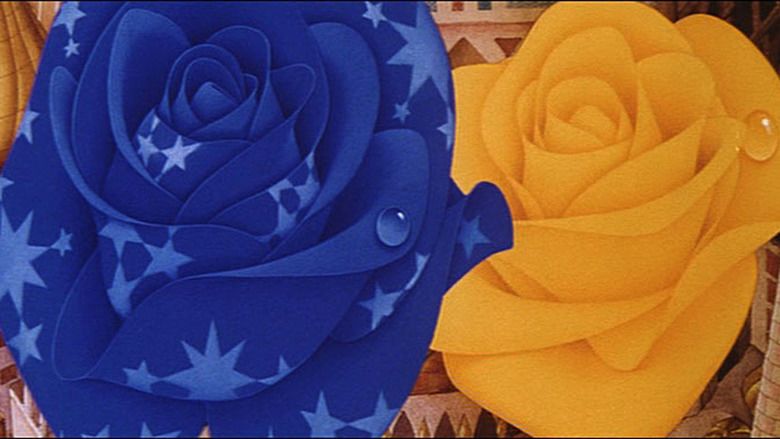
The film opens with a narrator describing a prosperous city called the Golden City, ruled by the sleepy King Nod and protected by three golden balls atop its tallest minaret. According to a prophecy, the city would fall to a race of warlike, one-eyed monsters, known as "One-Eyes", should the balls be removed, and could only be saved by "the simplest soul with the smallest and simplest of things". Living in the city are the good-hearted cobbler Tack, named for the ubiquitous pair of tacks held in his mouth, and a nameless, unsuccessful yet persistent thief.
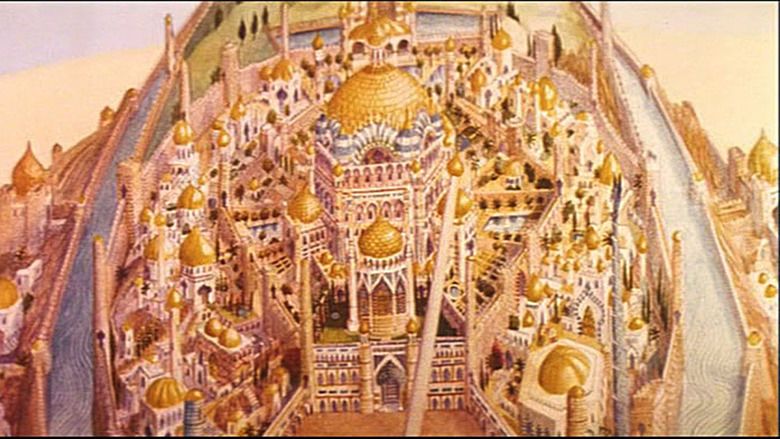
When the thief sneaks into Tack's house, the two fight and stumble outside, causing Tack's tacks to fall onto the street. Zigzag, King Nod's Grand Vizier, steps on one of the tacks and orders Tack to be arrested while the thief escapes. Tack is brought before King Nod and his daughter, Princess Yum-Yum. Before Zigzag can convince Nod to have Tack executed by beheading, Yum-Yum saves Tack by breaking one of her shoes and ordering him to fix it. During repairs, Tack and Yum-Yum become increasingly attracted to each other, much to the jealousy of Zigzag, who plots to take over the kingdom by marrying the princess. Meanwhile, the thief notices the golden balls atop the minaret and decides to steal them. After breaking into the palace through a gutter, the thief steals the repaired shoe from Tack, prompting the cobbler to chase him through the palace. Upon retrieving the shoe, Tack bumps into Zigzag, who notices the shoe is fixed and imprisons Tack in a dungeon.
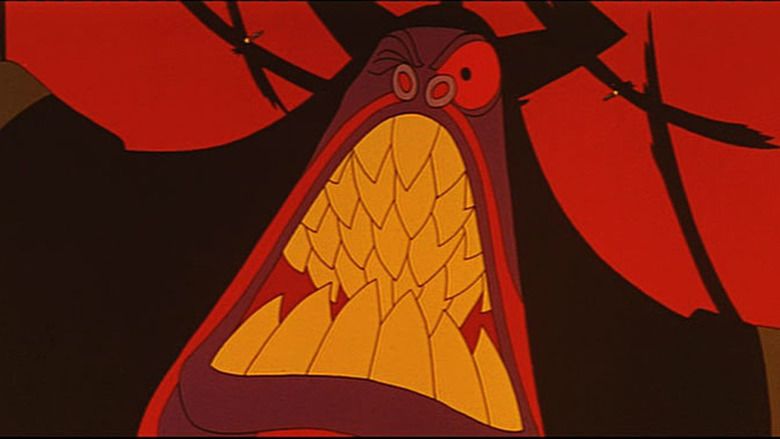
The next morning, Nod has a vision of the Golden City's destruction by the One-Eyes. While Zigzag tries to convince Nod of the kingdom's security, the thief steals the balls after several failed attempts, only to lose them to Zigzag's minions; Tack escapes from his cell using his cobbling tools during the ensuing panic. Nod notices the balls' disappearance when a mortally wounded soldier warns them of the invading One-Eyes. Zigzag attempts to use the stolen balls to blackmail the king into letting him marry Yum-Yum. When Nod dismisses him, Zigzag defects to the One-Eyes and gives them the balls instead.
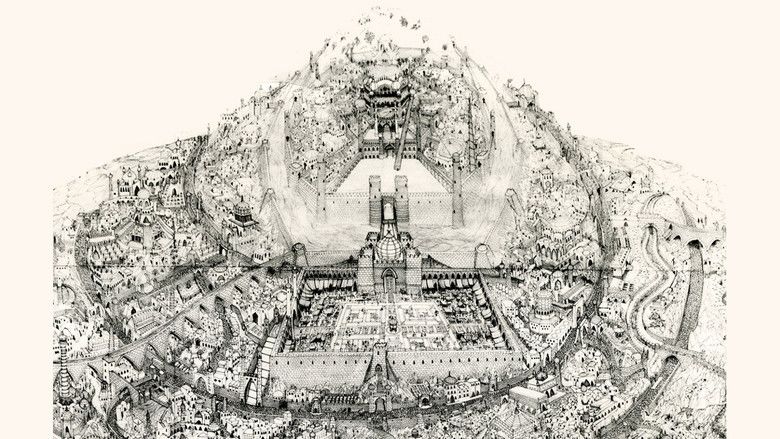
Nod sends Yum-Yum, her nurse, and Tack to ask help from a "mad and holy old witch" in the desert. They are secretly followed by the thief, who hears of treasures on the journey but fails in stealing any. In the desert, they discover a band of dimwitted brigands, led by Chief Roofless, whom Yum-Yum recruits as her bodyguards. The protagonists reach the hand-shaped tower where the witch lives, and, after the witch kills herself, learn that Tack is prophesied to save the Golden City. The witch also presents a riddle: "Attack, attack, attack! A tack, see? But it's what you do with what you've got!" before destroying the entire tower with a storm cloud.
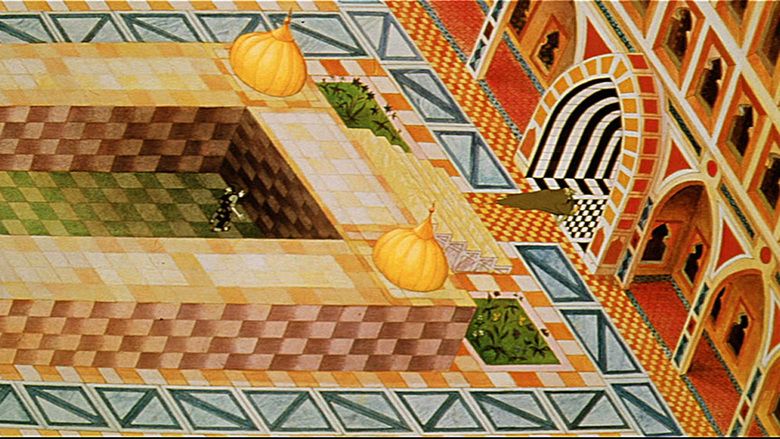
The protagonists return to the Golden City to find the One-Eyes' massive war machine approaching. Remembering the witch's riddle, Tack shoots a single tack into the enemy's midst, sparking a Goldberg-esque chain reaction that destroys the entire One-Eye army. Zigzag tries to escape, but falls into a pit where he is consumed by alligators and his fat lazy vulture, Phido. The thief, avoiding many deathtraps, steals the golden balls from the collapsing machine, only to have them taken from him by Tack. With peace restored and the prophecy fulfilled, the city celebrates as Tack and Yum-Yum marry. The story ends with the thief stealing its reel of film and running away.
Changes made in subsequent versions

The Allied Filmmakers cut is drastically different from Williams's workprint. Four musical numbers have been added; the film originally had none. Many scenes have been cut: These primarily consist of scenes involving the thief, most notably his attempted theft of an emerald and his subsequent evasion of capital punishment for it, and the subplot wherein Zigzag tries to feed Tack to Phido. Also removed are any references to the maiden from Mombassa, whom Zigzag gives to King Nod as a "plaything" in the workprint. Tack, almost mute in the workprint, speaks several times and narrates most scenes in past tense; the workprint had narration only in the beginning by a voice-over. Some subplots have been added; in one, Yum-Yum is tired of living a life of "regal splendor", and wishes to prove her worth to her father. Another subplot sees the nurse initially disliking Tack, and scolding Yum-Yum for harboring romantic feelings for him, but warming to him later on. There are also several lines of alternate or removed dialogue.
The Miramax cut includes all changes made in the Allied Filmmakers cut. In addition, several previously mute characters are given voices, most notably the thief, who narrates over all of his scenes in the form of an inner monologue. The Golden City is now referred to as Baghdad. Most scenes featuring the Mighty One-Eye's slave women in detail have been removed, although he can still be seen sitting on them. The sequence featuring the witch has been almost entirely removed, as is most of the climactic battle sequence, which had already been greatly shortened in the Allied cut. One-Eye's death is cut, though he can be heard crying: "My machine!" as the war machine burns, whereupon he presumably burns with it.
Garrett Gilchrist's fan restorations mostly follow Richard Williams's workprint very closely, at least in their intent, using most of its original audio track and editing structure. In order to present a more complete film, Gilchrist added additional music (some from the released versions) and sound effects, and also included finished footage that does not appear in a finished state in the workprint, whether taken from the released versions or from other rare sources. Most of the story changes made by Fred Calvert and Miramax are not present, but it does include a few minor Calvert-only scenes or alterations, either as a side effect of using Calvert's footage for a major video source or because Gilchrist felt these scenes were useful to the plot. For this reason, Gilchrist does not refer to his edit as a "Director's Cut."
Notes
^a According to Richard Williams, Sean Connery was going to record Tack's one line, but never showed up at the studio, so the line was instead performed by a friend of his wife's.
^b While Yum-Yum's dialogue was mostly re-voiced by Bobbi Page for the Allied Filmmakers version, one line of Crowe's dialogue is retained when Yum-Yum throws her pear at Zigzag in disgust during the polo game.
^c In both of the 1992 workprints, the thief is heard making short grunts/wheezes in a few scenes – though not as many as in the Allied Filmmakers version. It is unclear who provided these sounds, but it is known that Carroll did the additional ones for the Allied Filmmakers version.
^d Although Quayle's voice was mostly re-dubbed by Revill in the re-edited versions of the film by Allied Filmmakers and Miramax, Quayle's uncredited voice can still be heard for an entire scene when King Nod gives a speech to his subjects.
^e Sims' voice for the Witch was mostly re-dubbed by Marshall, but a few lines spoken by Sims were retained when she first fully materializes and when she receives her chest of money all the way up to the part when she's in a basket lighting a match to the fumes.
Hilary Pritchard was initially cast as Yum-Yum and is listed in a 1989 Cannes brochure. By the time of the 1992 workprints she had been replaced by Sara Crowe.
Similarly, Miriam Margolyes was initially billed as the Maiden from Mombassa, but the workprint features co-writer Margaret French as the Maiden.
According to animator Michael Sporn, Paul Matthews was a delivery person with a deep, dark voice whom Williams met in an elevator on the way to a rehearsal space during production on Raggedy Ann and Andy: A Musical Adventure. Matthews had not done any acting before, and so Williams had promptly cast him as the Mighty One-Eye. Not long afterwards, however, Williams, wanting to go in a different direction, replaced Matthews' voice with "England's tallest man" Christopher Greener (mistakenly credited as Christopher Greenham or Chris Greenham) as the Mighty One-Eye.
Catherine Schell would have played Princess Meemee, the sister of Princess Yum-Yum, and Thick Wilson played the enchanted ogre prince Bubba. Both characters were dropped in 1989 at the request of Warner Bros.
Development and early production as Nasrudin (1964–1972)
In 1964, Richard Williams, a Canadian animator living in the United Kingdom, was running an animation studio assigned to animate commercials and special sequences for live-action films. Williams illustrated a series of books by Idries Shah, which collected the tales of Mulla Nasruddin. Nasruddin was a philosophical yet "wise fool" of Near Eastern folklore. Williams began development work on a film based on the stories, with Shah and his family championing production. Idries Shah demanded 50% of the profits from the film, and Idries Shah’s sister Amina Shah, who had done some of the translations for the Nasrudin book, claimed that she owned the stories. Production took place at Richard Williams Productions in Soho Square, London. An early reference to the project came in the 1968 International Film Guide, which noted that Williams was about to begin work on "the first of several films based on the stories featuring Mulla Nasruddin."
Williams took on television and feature-film title projects in order to fund his project, and work on his film progressed slowly. Williams hired legendary Warner Bros. animator Ken Harris as a chief animator on the project, which was then entitled The Amazing Nasrudin. Designer Roy Naisbitt was hired to design backgrounds for the film, and promotional art showed intricate Indian and Persian designs. In 1970, the project was re-titled The Majestic Fool. For the first time, a potential distributor for the independent film was mentioned: British Lion Film Corporation. The International Film Guide noted that the Williams Studio's staff had increased to forty people for the production of the feature. Williams gained further attention when he and the studio produced a TV adaptation of A Christmas Carol for Chuck Jones, which won the studio an Academy Award for Best Animated Short Film.
Dialogue tracks for the film, now being referred to as just Nasrudin, were recorded at this time. Actor Vincent Price was hired to perform the voice of the villain, Anwar (later renamed "Zigzag"), originally assigned to Kenneth Williams. Sir Anthony Quayle was cast as King Nod. Price was hired to make the villain more enjoyable for Williams, as he was a great fan of Vincent Price's work and ZigZag was based on two people Williams hated.
By 1972, Williams and the studio had animated around three hours of footage for Nasrudin, according to composer Howard Blake. Blake insisted to Williams that while he thought the footage was excellent, he needed to structure the film and his footage into a three-act plot. The Shah family had a bookkeeper that wasn't keeping track of the studio's accounting, so Williams felt that producer Omar Shah had been embezzling financing from the studio for his own purposes. As a result, Williams had a falling-out with the Shah family. Paramount withdrew a deal that they'd been negotiating. Williams was forced to abandon Nasrudin, as the Shah family took the rights of Williams' illustrations. However the Shah family allowed Williams to keep characters he designed for the books and the movie, including a thief character that was Williams' favorite.
Prolonged production (1972–1978)
Williams commissioned a new script from Howard Blake, he wrote a treatment called Tin Tack in 1973. Blake's treatment incorporated a clumsy cobbler named Tack and retained Williams' thief character from Nasrudin. While the story's focus and tone was shifted and simplified, Williams' characters from Nasrudin, including a sleepy king and an evil vizier originally named Anwar, all moved over to Tin Tack. Many scenes that did not include Nasrudin himself were also retained. Throughout the 1970s, Williams would further re-write the script with Margaret French, his wife at the time. While Williams would continue to simplify the dialogue, the script would not change structurally.
Williams later began promising his new film as a "100 minute Panavision animated epic feature film with a hand-drawn cast of thousands." The characters were renamed at this point. Zigzag speaks mostly in rhyme throughout the entire film, while the other characters -with the exception of the Thief and Tack who are mute- speak normally. Richard Williams stated that he did not intend to follow "the Disney route" with his film. He went on to state that the film would be "the first animated film with a real plot that locks together like a detective story at the end," and that, with its two mute main characters, Thief was essentially "a silent movie with a lot of sound." Silent comedies, like films from Charlie Chaplin and Harry Langdon, were already an inspiration on Nasrudin and carried over to the new film. Tack was modeled after said silent film stars.
British illustrator Errol Le Cain created inspirational paintings and backgrounds, setting the style for the film. During the decades that the film was being made, the characters were redesigned several times, and scenes were reanimated. Test animation of Princess Yum-Yum, as featured in the released versions, was traced from the live-action film Muqaddar Ka Sikander – her design was slightly changed later into production. In Williams' early drafts, the climax included a final battle with Zigzag after the collapse of the War Machine, where he conjures a larger-than-life Oriental dragon only for Tack to reveal it to be nothing more than an inflatable balloon. Although there were some production designs of the scene with the Oriental dragon, it was never made, as it was found to be too difficult to animate.
In 1974, a recession forced the studio to focus primarily on various TV commercial, TV special, and feature film title assignments, leaving Williams' movie to be worked on as a side project. Because Williams had no money to have a full team working on the film, and due to the film being a "giant epic", production dragged for decades. Ken Harris was still the chief animator on the film, as he had been since Nasrudin, and Williams would assign him sequences while he was supervising production on commercials. To save money, scenes were kept in pencil stage without putting it into colour, as advised by Richard Purdum: "Work on paper! Don’t put it in colour. Don’t spend on special effects. Don’t do camera-work, tracing or painting... just do the rough drawings!" Williams was planning to later finish these sequences when the financing would come in.
Williams was learning the art of animation himself during the production of his film, before The Thief his animation during the 1960s typically featured stylized designs in the vein of UPA animated shorts. Williams hired veteran animators from the golden age of animation, such as Art Babbitt, Emery Hawkins and Grim Natwick to work in his studio in London and help teach him and his staff: Williams learned also from Milt Kahl, Frank Thomas, Ollie Johnston and Ken Anderson at Disney, to whom he made yearly visits. Williams would later pass their knowledge to the new generation of animators. Williams also allowed animators like Natwick and Babbitt to work on the studio assignments, such as the 1977 feature Raggedy Ann & Andy: A Musical Adventure. The Mad Holy Old Witch was designed as a caricature of animator Grim Natwick, by whom she was animated. After Natwick died, Williams would animate the Witch himself.
As years passed, the project became more ambitious. Williams said that "the idea is to make the best animated film that has ever been made – there really is no reason why not." Williams envisioned the film to feature very detailed and complex animation, the likes he thought no other studio would attempt to achieve. Additionally, much of the film's animation would be photographed "on ones", meaning that the animation runs at full 24 frames per second, as opposed to the more common animation "on twos" in twelve frames per second.
Gaining financial backing (1978–1988)
In 1978, a Saudi Arabian prince, Mohammed bin Faisal Al Saud, became interested in The Thief and agreed to fund a ten-minute test sequence, with the budget of $100,000. Williams chose the complex, penultimate sequence of the Thief in the War Machine for the test. The studio missed two deadlines, and the scene was completed in the end of 1979 for $250,000. Faisal, despite his positive impression of the finished scene, backed out of the production because of missed deadlines and budgetary overruns.
In the 1980s, Williams put together a 20-minute sample reel of The Thief, which he showed to Milt Kahl, friend and one of Williams' animation mentors, at Skywalker Ranch in Marin County. Star Wars producer Gary Kurtz even worked with Williams to attempt to get financing in the mid-1980s. Kurtz later left The Thief. In 1986, Williams met producer Jake Eberts, who began funding the production through his Allied Filmmakers company and eventually provided USD$10 million of the film's $28 million budget. Allied's distribution and sales partner, Majestic Films, began promoting the film in industry trades, under the working title Once....
At this time, Eberts encouraged Williams to make changes to the script. A subplot involving the characters of Princess Mee-Mee, Yum-Yum's twin sister played by Catherine Schell, and the Prince Bubba, who had been turned into an ogre, and was played by Thick Wilson. Both characters were deleted and some of Grim Natwick's animation of the Witch had to be discarded. Also deleted was Ken Harris' sequence of a Brigand dreaming of a Biblical temptress.
Steven Spielberg saw the footage of The Thief and was impressed enough that he, with film director Robert Zemeckis, asked Williams to direct the animation of Who Framed Roger Rabbit. Williams agreed in order to get financing for The Thief and the Cobbler and get it finally finished. Roger Rabbit was released in 1988, and became a blockbuster. Williams won two Oscars for his animation and contributions to the visual effects. Although Roger Rabbit ran over-budget before animation production began, the success of the film proved that Williams could work within a studio structure and turn out high-quality animation on time and within budget. Disney and Spielberg told Williams that in return for doing Roger Rabbit, they would help distribute his film. This plan did not come to pass. Disney began to put their attention more in its own feature animation, while Spielberg instead opened a rival feature animation studio in London.
Because of his success, Williams and Warner Bros. negotiated a funding and a distribution deal for The Thief and the Cobbler, which included a $25 million marketing budget. Williams' current wife, Imogen Sutton, suggested him to finance The Thief with European backers, citing his appreciation of foreign films. Richard insisted he could produce the film with a major studio. Williams and Warners signed a negative pickup deal in late 1988, and Williams also got some financial aid from Japanese investors. Williams himself later stated, "In hindsight we should have just gone to Europe, take another five years, made it on our own, and then go to a distributor and get people who find it as a novelty."
Production under Warner Bros. (1989–1992)
With the new funding, the film finally got into full production in 1989. Williams scoured the art schools of Europe and Canada to find talented artists. It was at this point, with almost all of the original animators either dead or having long since moved on to other projects, that full-scale production on the film began, mostly with a new, younger team of animators, including Williams's own son Alexander Williams. In a 1988 interview with Jerry Beck, Williams stated that he had two and a half hours of pencil tests for Thief and that he had not storyboarded the film as he found such a method too controlling. Vincent Price originally recorded his dialogue from 1967 to 1973. Williams recorded further dialogue with Price for the 1990 production, but Price's age and illness meant some lines remained unfinished.
Williams had before experimented with shots animated by hand to move in three dimensions with characters, including several shots in Roger Rabbit's opening sequence. With The Thief, Williams began planning several sequences to feature a greater use of this animation technique, including Tack and the Thief's palace chase – which was achieved without computer-generated imagery. According to rumors, Williams approached The Thief with a live-action point of view coming off of Roger Rabbit. Williams was creating extra footage and extending sequences to trim down later and that he would have edited down the workprint he later assembled.
Warner Bros. had also signed a deal with The Completion Bond Company to ensure the studio would be given a finished film, if not they would finish The Thief under their management. Williams, dedicated but pressured, was taking his time to ensure sequences would look perfect. Animators were working overtime, sometimes sixty hours a week required, to get the film done. While Williams encouraged the best out of people, discipline was harsh and animators were frequently fired. "He fired hundreds of people. There's a list as long as your arm of people fired by Dick. It was a regular event." cameraman John Leatherbarrow recalls, "There was one guy who got fired on the doorstep." Williams was just as hard on himself: "He was the first person in the morning and the last one out at night," recalls animator Roger Vizard. Funders pressured Williams to make finished scenes of the main characters for a marketing trailer. The final designs were made for the characters at this time.
The film was not finished by a 1991 deadline that Warner originally imposed upon Williams; the film had approximately 10 to 15 minutes of screen time to complete, which at Williams's rate was estimated to take "a tight six months" or longer. From Warner Bros.' perspective, the animation department at the studio had put their enthusiasm towards high-quality television animation but had little confidence towards backing feature animation. Warner Bros. had already released The Nutcracker Prince, a Canadian-produced animated feature, in 1990 to almost no promotion. Warner's head of animation Jean MacCurdy didn't know anything about animation, as she admitted to an artist that had worked for Williams while she was seeing footage of The Thief. Another animator working in Warner Bros. salvaged almost 40 minutes of 35mm dailies footage from MacCurdy's trash. Meanwhile, Walt Disney Feature Animation had begun work on Aladdin, a film which bore striking resemblances in story, style and character to The Thief and the Cobbler; for example, the character Zigzag from Thief shares many physical characteristics with both Aladdin's villain, Jafar, and its Genie, as animated by Williams Studio alumnus Andreas Deja and Eric Goldberg
The Completion Bond Company asked television animation producer Fred Calvert to do a detailed analysis of the production status. He had already traveled to Williams's London studio several times to check on the progress of the film, and his conclusion was that Williams was "woefully behind schedule and way over budget." Williams did indeed have a script, according to Calvert, but "he wasn't following it faithfully." People from the Completion Bond Company, and Calvert, were visiting the studio more often towards the end. Williams was giving dailies of sequences that were finished or scrapped since the 1980s, hoping to give an indication of progress to Warner Bros. Williams was asked to show the investors a rough copy of the film with the remaining scenes filled in with storyboards in order to establish the film's narrative. Williams had avoided storyboards up to this point, but within two weeks he had done what the investors had asked. Williams made a workprint which combined finished footage, pencil tests, storyboards, and movements from the symphonic suite, Scheherazade, to cover the 10–15 minutes left to finish. Animators found out that they had completed more than enough footage for an 85-minute feature, but they had yet to finish certain sequences involving the central story.
In May 13, 1992, this rough version of the film was shown to Warner Bros., and was not well received. During the screening, the penultimate reel of the film was missing, which did not help matters. The studio lost confidence and backed out of the project. The Completion Bond Company seized control of the film, ousting Williams from the project. Jake Eberts, who at this point was an executive producer, also abandoned the project. Additionally, according to Richard Williams himself, the production had lost a source of funding when Japanese investors pulled out due to the recession following the Japanese asset price bubble. Fans cite this decision as an example of a trend of animated films being tampered with by studio executives.
Production under Fred Calvert (1992–1993)
Sue Shakespeare of Creative Capers Entertainment had previously offered to solve story problems with Richard Williams, suggested to bring in Terry Gilliam to consult, and proposed to allow Williams to finish the film under her supervision. Williams reportedly agreed to Shakespeare's proposal, but her bid was ultimately rejected by the Completion Bond Company in favor of a cheaper one by Fred Calvert. Calvert was assigned by the Completion Bond Company to finish the film as cheaply and quickly as possible. "I really didn't want to do it," Calvert said, "but if I didn't do it, it would have been given off to the lowest bidder. I took it as a way to try and preserve something and at least get the thing on the screen and let it be seen."
It took Calvert 18 months to finish the film. The new scenes were produced on a much lower budget, with the animation being produced by freelance animators in Los Angeles and former Williams animators working with Neil Boyle at Premier Films in London. Sullivan Bluth Studios and Kroyer Films animated two of the song sequences. The ink and paint work was subcontracted to Wang Film Productions in Taiwan and its division Thai Wang Film Productions in Thailand, and outsourced to Varga Studio in Hungary, with help from Rough Draft Studios in Glendale, California and its Korean division in Seoul, South Korea.
Approximately 18 minutes of completed animation were cut by Calvert, due to the repetitive nature of the scenes. Calvert said "We hated to see all this beautiful animation hit the cutting room floor, but that was the only way we could make a story out of it. He [Williams] was kind of Rube Goldberg-ing his way through. I don't think he was able to step back and look at the whole thing as a story. He's an incredible animator, though. Incredible. One of the biggest problems we had was trying our desperate best, where we had brand new footage, to come up to the level of quality that he had set."
Releases
After the movie was completed, Allied Filmmakers, along with Majestic Films, reacquired the distribution rights from the Completion Bond Company. Calvert's version of the film was distributed in Australia and South Africa as The Princess and the Cobbler on 23 September 1993.
In December 1994, Miramax Films, then a subsidiary of Disney and had already released Aladdin first, bought the rights in North America. Until Miramax agreed to distribute the film, it was refused by many other American distributors. "It was a very difficult film to market, it had such a reputation," Calvert recalls. "I don't think that they were looking at it objectively." Originally planning to release the Princess and the Cobbler version, Harvey Weinstein decided to recut the film even further and released their version entitled Arabian Knight. This version featured newly written dialogue by Eric Gilliland, Michael Hitchcock, and Gary Glasberg, and a celebrity voice cast that was added months before the film's release.
Jake Eberts found that "It was significantly enhanced and changed by Miramax after they stepped in and acquired the domestic -distribution- rights." His comments on record, claiming that these altered versions were superior to Williams's version, indicate that Eberts had also lost confidence in Williams when The Completion Bond Company seized the film. Arabian Knight was quietly released by Miramax on 25 August 1995. It opened on 510 screens, and grossed US$319,723 (on an estimated budget of $24 million) during its theatrical run.
Home media
The Miramax version of the film was to be released on VHS in December 1995, months after its theatrical release. But it was eventually released on 18 February 1997, re-titled as The Thief and the Cobbler. A widescreen LaserDisc was also released. The first time that the Miramax version of the film appeared on DVD was in Canada in 2001 as a giveaway promotion in packages of Kellogg's cereal. This pan and scan DVD was released through Alliance Atlantis, which distributes many of Miramax's films in Canada. It came in a paper sleeve and had no special features, other than the choice of English or French language tracks. The Miramax version was first released commercially on DVD, in Japan only, in 2002. Released by the Daiichi Kosho Company, this release used a widescreen copy of Miramax's Arabian Knight version and contained English and Japanese language tracks.
The Allied Filmmakers version was released on a pan and scan DVD in Australia in 2003 by Magna Pacific, according to some sites; however, it is severely cropped, and there are no additional features on the DVD.
A commercially released North American DVD of the Miramax version was released on 8 March 2005, in pan-and-scan format. This DVD was re-released by The Weinstein Company on 21 November 2006. Although the information supplied to online retailers said that it would be a new special edition, it was in fact just a reissue of Miramax's earlier DVD with revised packaging. The 2006 DVD has been found by most reviewers to be unsatisfactory, the only extra features being trailers for other Weinstein Company family films. The Digital Bits listed it as the worst standard-edition DVD of 2006. The Miramax/Weinstein DVD was re-issued again on 3 May 2011 by Echo Bridge Home Entertainment, an independent DVD distributor who made a deal to release 251 titles from the Miramax library until the deal expired in 2014.
The Miramax version was also released on DVD in the United Kingdom on 13 February 2012. The film had previously never been released in any form there, where the majority of the production took place.
Reception
The Miramax version of the film was a commercial failure and received mixed-to-negative reviews. Film website Rotten Tomatoes gave the film a score of 50% based on 8 reviews. Carn James of the New York Times criticised the songs sung by the princess, calling the lyrics "horrible" and the melodies "forgettable", though he did praise Williams's animation as "among the most glorious and lively ever created". Animation historian Jerry Beck felt that the added voiceovers of Jonathan Winters and Matthew Broderick were unnecessary and unfunny, and that Fred Calvert's new footage didn't meet the standards of the original Williams scenes. However, in 2003, the Online Film Critics Society ranked the film as the 81st greatest animated film of all time. In addition, the film won the 1995 Academy of Family Films Award.
Alex Williams, son of the original director, criticized changes made by Calvert and Miramax, called the finished film "more or less unwatchable" and found it "hard to find the spirit of the film as it was originally conceived". For years, Richard Williams was devastated by the film's production and had never publicly discussed it since then. In 2010, he did speak about The Thief and the Cobbler in an interview about his silent animated short, Circus Drawings, a project he shelved in the 1960s before he started work on the film. Three years later, he later participated in Q&As for screenings of his 1992 workprint at the Samuel Goldwyn Theater on 10 December 2013 and at the BFI Southbank in London on 1 June 2014. Williams also said he has never seen the Calvert and Miramax versions of the film, saying "I'm not interested, but my son, who is also an animator, did tell me that if I ever want to jump off a bridge then I should take a look."
Influence
The Secret of Kells and Song of the Sea, two Irish-animated films that based its style on traditional native art, had The Thief and the Cobbler cited as one of their main inspirations. Tomm Moore, the director of both films, said "Some friends in college and I were inspired by Richard Williams's unfinished masterpiece The Thief and the Cobbler and the Disney movie Mulan, which took indigenous traditional art as the starting point for a beautiful style of 2D animation. I felt that something similar could be done with Irish art."
Restoration attempts
Richard Williams' workprint was bootlegged, after Calvert's versions were released, and copies for years have been shared among animation fans and professionals. The problem in creating a high-quality restoration is that after the Completion Bond Company had finished the film, many scenes by Williams that were removed disappeared – many of these had fallen into the hands of private parties. Before losing control of the film, Williams had originally kept all artwork safe in a fireproof basement. Additionally, there are legal problems with Miramax.
At the 2000 Annecy Festival, Williams showed Walt Disney Feature Animation head Roy E. Disney his workprint of The Thief, which Disney liked. With Williams' support, Roy Disney began a project to restore The Thief and the Cobbler. He sought out original pencil tests and completed footage. Roy Disney left the Walt Disney Company in November 2003, and the project was put on hold. Disney film producer Don Hahn was later made the project supervisor of the restoration. Since Roy's death in 2009, the project was once again put on hold.
In 2006, a filmmaker, artist, and fan of Williams's work named Garrett Gilchrist created a non-profit fan restoration of William's workprint, named The Thief and the Cobbler: The Recobbled Cut. It was done in as high quality as possible by combining available sources at the time, such as a heavily compressed file of Williams's workprint and better-quality footage from the Japanese DVD of Arabian Knight. This edit was much supported by numerous people who had worked on the film (with the exception of Richard Williams himself), including Roy Naisbitt, Alex Williams, Andreas Wessel-Therhorn, Tony White, Holger Leihe, Simon Maddocks, Neil Boyle, and Steve Evangelatos, many of whom lent rare material for the project. Some minor changes were made to "make it feel more like a finished film", like adding more music and replacing storyboards with some of Fred Calvert's animation. Certain scenes, like the wedding ending, had to be redrawn frame by frame by Gilchrist due to flaws in the footage. Gilchrist described this as the most complex independent restoration of a film ever undertaken. This edit gained positive reviews on the Internet. Twitch Film called it "the best and most important 'fan edit' ever made".
The Recobbled Cut has been revised three times in 2006, 2008, and 2013. Each version incorporated further higher-quality materials donated by animators from the film, including two rare workprints from the Fred Calvert production that contained footage not available in the released versions. The "Mark 3" version released in 2008 incorporated 21 minutes from a 49-minute reel of rare 35mm film. Gilchrist's last version, "Mark 4", was released in September 2013 and edited in HD. "Mark 4" features about 30 minutes of the film in full HD quality, restored from raw 35mm footage which Gilchrist edited frame by frame. Artists were also commissioned to contribute new artwork and material. Gilchrist's YouTube account, "TheThiefArchive", now serves as an unofficial video archive of Richard Williams' films, titles, commercials, and interviews, including footage from the Nasrudin production. Williams said that while he hasn't seen Gilchrist's Recobbled Cut, acknowledged the role that the fan edits had played in rehabilitating the film's reputation.
Academy preservation
On October 2013, Williams announced that his workprint of the film, subtitled "A Moment in Time", would be screened on 10 December 2013 in Los Angeles. Williams stated that his workprint, from 13 May 1992, is now archived and digitally duplicated by the Academy of Motion Picture Arts and Sciences. "The Academy has it, it's in a "golden box" now and it's safe," Williams said. The workprint, along with a selection of Art Babbitt's animation from the film, have been placed in an archive collection named "The Art Babbitt Collection". A collection of artwork from The Thief is also stored in Disney's "Animation Research Library" in the Feature Animation building.
The workprint was screened at the Academy's Samuel Goldwyn Theater, on 10 December 2013, with Williams in attendance. Also attending the screening were other notable animation artists, even crew from Disney's Aladdin attended the screening, including animator Eric Goldberg, composer Alan Menken, and directors John Musker and Ron Clements. After the screening Williams discussed the origins of the film and its production history. On 1 June 2014, "A Moment in Time" was screened in London, with many of the original crew present.
Documentary
Persistence of Vision is a documentary by Kevin Schreck, about Richard Williams and the production of The Thief and the Cobbler, which the film calls "the greatest animated film never made." Because Williams did not participate in the documentary, it is instead a documentary from the perspective of animators and artists who had worked with Richard Williams and his studio during the film's lengthy production. Williams is featured in the documentary, through archival interviews. Garrett Gilchrist and Helge Bernhardt of the Recobbled Cut and Richard Williams Archive provided rare materials to Schreck for his production, which was funded via Kickstarter.
First premiering in 2012 at the Vancouver International Film Festival, it has received many awards at festivals and has gotten a very positive critical reception. Williams was given a copy of the film, but he said doesn't plan on watching it.
The thief and the cobbler nostalgia critic
References
The Thief and the Cobbler WikipediaThe Thief and the Cobbler IMDb The Thief and the Cobbler themoviedb.org
